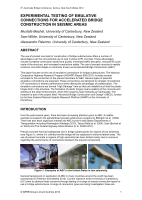Bridges

Experimental Testing of Emulative Connections for Accelerated Bridge Construction in Seismic Areas
- Publication no: ABC-CAS102-14
- Published: 22 October 2014
- PDF (free) Download
The use of precast concrete for construction of bridge substructures offers a number of advantages over the conventional use of cast in place (CIP) concrete. These advantages include increased construction speed and quality, minimised traffic disruption, reduced life-cycle costs of the structure, and increased construction safety. The use of precast concrete to rapidly construct concrete bridges is commonly known as Accelerated Bridge Construction (ABC). This paper focuses on the use of emulative connections for bridge substructures. The National Cooperative Highway Research Program Report 698 (2011) includes several concepts for the connection of the precast members for ABC. Several types of potential emulative connections are proposed. These connections are designed to emulate conventional CIP connections in seismic performance while offering the advantages of prefabrication. The emulative connections are termed high damage here as they are detailed such that the plastic hinges form in the structure. The formation of plastic hinges means spalling of the concrete and yielding of the steel reinforcement, which then requires repair following an earthquake. The research is part of the project titled Advanced Bridge Construction and Design, funded by the New Zealand Natural Hazards Research Platform at the University of Canterbury.
Related publications
ATM-780-23
ATS-5315-23
ATS-5341-23
Latest Bridges News
